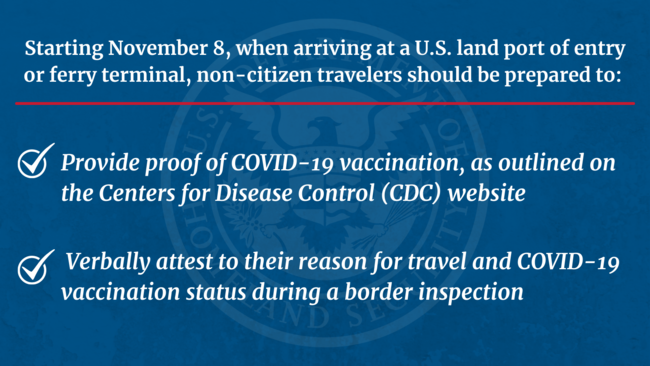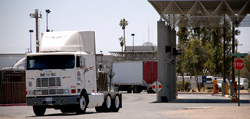San Diego/Otay, CA
Back to San Diego/Otay, CA
Release Date: October 29, 2021
Starting Monday, November 8, 2021, new requirements will go into effect for travelers entering the United States at land ports of entry (POEs) and ferry terminals.
For the first time since March 2020, non-citizen travelers will be permitted to enter the U.S. through a land border or ferry terminal for a non-essential reason (i.e., tourism), provided they are fully vaccinated and can present proof of COVID-19 vaccination status. Unvaccinated travelers may continue to cross the border for essential travel, including lawful trade, emergency response, and public health purposes.
Requirements
As travel begins to resume, travel volumes and wait times are expected to increase. The resources below are intended to prepare travelers and equip them with the information they need to improve their cross-border travel experience. Travelers should plan for longer than normal wait times and long lines at U.S. land border crossings when planning their trip and are reminded to exercise patience.
To help reduce wait times and long lines, travelers can take advantage of innovative technology, such as facial biometrics and the CBP OneTM mobile application, which serves as a single portal for individuals to access CBP mobile applications and services.
Arrival at Land Port of Entry or Ferry Terminal

Fully vaccinated, non-citizen travelers with appropriate documentation will be permitted to enter the United States for non-essential travel via land POE and ferry terminals starting on November 8, 2021.
This shift eases long-standing restrictions on non-essential travel, consistent with public health guidance. U.S. Customs and Border Protection (CBP) will soon share additional information about the steps eligible travelers will need to take to enter the United States under the new rules.
Starting November 8, when arriving at a U.S. land POE or ferry terminal, non-citizen travelers should be prepared to:
- present proof of COVID-19 vaccination as outlined on the CDC website; and,
- verbally attest to their non-essential travel and COVID-19 vaccination status.
Individuals engaged in essential travel will not be required to be vaccinated at this time. Starting in January 2022, however, all inbound foreign national travelers crossing U.S. land POEs or ferry terminals – whether for essential or non-essential reasons – must be fully vaccinated for COVID-19 and provide related proof of vaccination.
Click here to see answers to frequently asked questions
Background
In March 2020, to prevent the further spread of COVID-19, the U.S. government issued restrictions on travel into the United States. CBP implemented temporary restrictions limiting entry at the U.S. northern and southern land borders to persons engaged in essential travel, including lawful trade, emergency response, and public health purposes. The White House suspended entry to foreign nationals who had recently been in certain countries. As the COVID-19 pandemic continued, various restrictions and requirements for foreign travel remained in place.
In October 2021, the White House announced that, starting November 8, the U.S. government would move away from the country-by-country restrictions previously applied during the COVID-19 pandemic and adopt travel policies that rely primarily on vaccination to advance the safe resumption of travel.
Frequently Asked Questions: Guidance for Travelers to Enter the U.S. at Land Ports of Entry and Ferry Terminals
For the first time since March 2020, non-citizen travelers will be permitted to enter the U.S. through a land border or ferry terminal for a non-essential reason (i.e., tourism), provided they are fully vaccinated and can present proof of COVID-19 vaccination status. Unvaccinated travelers may continue to cross the border for essential travel, including lawful trade, emergency response, and public health purposes.
The following are answers to frequently asked questions regarding the new rules. Click here to learn more about the updated guidance.
- Starting November 8, the US will lift restrictions to fully vaccinated non-citizens. What will change?
- Title 19 restrictions are still in place. But on Nov. 8, 2021, documented non-citizens who are fully vaccinated against COVID-19 will be able to cross the land borders with Canada and Mexico or arrive in the United States by passenger ferry for non-essential reasons, such as to visit friends or family or for tourism. These travelers are required to be prepared to attest to vaccination status and present proof of being fully vaccinated to a CBP officer upon request. Starting in January, both essential and non-essential travelers will be required to be fully vaccinated.
Q: What time on November 8 will these changes take effect?
A: More details will be forthcoming prior to November 8.
Q: How and where will travelers be able to find answers to their questions about this new policy?
A: CDC and the interagency have developed the orders and guidance to implement this new travel policy for the airlines, and for airline passengers. Approved vaccinations and required documentation outlined for air travel will be mirrored for land border travelers. Those details are available on the CDC website.
- What types of vaccinations will be accepted?
- CDC has determined that all FDA approved and authorized vaccines, as well as all vaccines that have an Emergency Use Listing (EUL) from the World Health Organization will be accepted for air travel. Land border travel will mirror the same guidelines.
Accepted Vaccines:
- CDC has determined that for purposes of travel to the United States, vaccines accepted will include current FDA approved or authorized vaccines and World Health Organization (WHO) emergency use listed (EUL) vaccines.
- Individuals are considered fully vaccinated:
- 2 weeks (14 days) after your dose of an accepted single-dose COVID-19 vaccine;
- 2 weeks (14 days) after your second dose of an accepted 2-dose series COVID-19 vaccine;
- 2 weeks (14 days) after you received the full series of an “active” (not placebo) COVID-19 vaccine in the U.S.-based AstraZeneca or Novavax COVID-19 vaccine trials; or
- 2 weeks (14 days) after you received 2 doses of any “mix-and-match” combination of accepted COVID-19 vaccines administered at least 17 days apart.
- More details are available in CDC guidance here.
- What are the requirements for travelers entering the United States through land borders?
- Before embarking on your trip to the U.S., travelers should be prepared for the following:
- Possess proof of an approved COVID-19 vaccination as outlined on the CDC
- During border inspection, verbally attest to their travel intent and COVID-19 vaccination status.
- S. citizensare reminded to bring a Western Hemisphere Travel Initiative document, such as a valid U.S. passport, Trusted Traveler Program card, Enhanced Driver’s License or Enhanced Tribal Card when re-entering the country. Citizens should be prepared to present the WHTI-compliant document and any other documents requested by the CBP officer.
- What are the requirements to enter the United States for children under the age of 18 who can't be vaccinated?
- Children under 18 years of age will be excepted from the vaccination requirement at land and ferry POEs when it goes into effect on November 8.
- Do you expect border wait times to increase?
- CBP’s Office of Field Operations (OFO) expects an increase in border wait times, especially at our busiest crossing locations. Trade and travel facilitation remain a priority, however, we cannot compromise national security which is our primary mission. Trade, which is vital to the American economy and post pandemic recovery, has seen an increase of over 8%. Narcotics seizures continue to rise with fentanyl and methamphetamines seeing dramatic increases in FY 2021. OFO will continue to delicately balance its finite resources with an emphasis on ensuring our borders are secure.
Q: What can travelers do to mitigate the anticipated increased wait times at the ports of entry?
A: To help reduce wait times and long lines, travelers can take advantage of innovative technology, such as the CBP OneTM mobile application. Launched on October 28, 2020, CBP OneTM is a mobile application that serves as a single portal for travelers and stakeholders to access CBP mobile applications and services. Through a series of intuitive questions, it will guide each user to the appropriate services based on their needs, including applying for an electronic I-94 up to seven days in advance of travel. The application can be downloaded for free from the Apple App Store or Google Play. The cost of applying for an I-94 using the mobile application is $6 USD, which is the same cost as applying on the I-94 website or upon arrival at a land port of entry. Although having an approved ESTA is not a requirement to enter the United States via the land border, citizens and nationals of Visa Waiver Program countries must have an active ESTA to use the CBP OneTM I-94 Apply feature. All individuals in specified locations/conveyance types may use the CBP One™ app on their smart devices. However, admissibility policies have not changed; if travelers must currently report in person for any reason (i.e., requiring an I-94, paying customs duties, etc.), they will continue to be required to do so.
Q: How will the Title 19 modifications affect U.S. citizens and Lawful Permanent Residents?
A: U.S. citizens, lawful permanent residents and those traveling for essential reasons are exempt from the non-essential travel restrictions on entry at U.S. land borders. U.S. Citizens returning to the United States at a land border port of entry need to present themselves for inspection by presenting a WHTI-compliant document to ensure the inspection process is streamlined.
The CBP One I-94 features are not intended for use by U.S. citizens, lawful permanent residents, foreign travelers with immigrant visas, or most Canadian citizens visiting the United States, as these particular travelers do not need I-94s
Otay Mesa Port of Entry
Customs and Border Protection
Latest News
Border Wait Times



